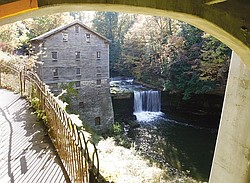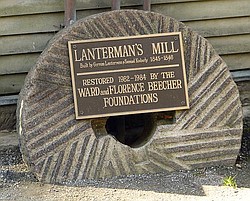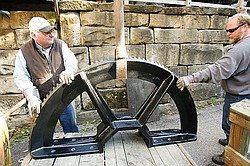New gear will get Lanterman's Mill wheel grinding again
GRINDSTONE: This grindstone is an example of the actual stones used in the milling of flour by Lanterman’s Mill. The divots in the stone act as knives to remove the hard hulls of buckwheat and corn, and the flat surfaces grind the grains into flour, a mill official said.
SHIFTING GEARS: Ted Lyda, left, manager of Lanterman’s Mill, and Curt Artman of Ridge Machine and Welding in Toronto, Ohio, assess two halves of the bull gear, which is placed on the water wheel of the mill. The parts, each weighing about 1,000 pounds, were delivered Monday and installed Thursday. In far right photo, the grindstone is an example of the stones used in the milling of flour by Lanterman’s Mill.
The mill’s main gears broke because of wear and were replaced.
By Jon Moffett
YOUNGSTOWN — Ted Lyda and the employees of Lanterman’s Mill are gearing up to get back to the daily grind.
A crew from Ridge Machine and Welding Co. in Toronto, Ohio, replaced two immense gears this week at the 164-year-old facility. The gears broke in June, and the mill has been out of operation since.
“We have a set of cast-iron gears that drive the mill off the waterwheel, and the wear on the teeth became so immense that the gears finally started to jump and break,” said Lyda, manager of the mill.
Bob Orr, a supervisor at the mill, said the entire building groaned and shook when the gears gave out. Lyda said the improvements should make the new gears last at least 30 years, but hopefully longer.
The gears were cast by the Columbiana Foundry Co. and were a custom fit. The bull gear is more than 6 feet in diameter and arrived in two pieces, each weighing about 1,000 pounds. When assembled, it attaches directly to the waterwheel.
The other gear, called the pinion, is much smaller and weighs only 305 pounds. It attaches to the bull gear and a vertical drive shaft that operates the mill.
The parts were delivered Monday and lowered by crane about 40 feet to the heart of the mill.
“These gears are everything,” said Curt Artman, vice president of Ridge Machine. “Without them, you can’t transfer the power from the water into the machine. It’s dead without these.”
Artman said that after installing the gears, the crew will make sure everything is calibrated and running efficiently, and the project should be completed by the end of next week. Lyda said the total cost of the project is about $25,000 with about $10,000 set aside for the casting of the parts.
The mill was renovated and became operational again in the mid-1980s, but Lyda said he wasn’t sure if the gears were new at the time they were installed.
The building still features many of the original structural elements from when Germany Lanterman built it in 1845, including the chestnut columns and beams and a 10-foot-thick sandstone foundation.
Artman said he can’t even imagine how the mill’s original construction took place.
“For us, this is amazing,” he said. “It’s so neat to be able to see the craftsmanship and engineering that went into something like this. And then to imagine that when they were putting this stuff in to begin with a couple hundred years ago, they were using ropes, pulleys, horses and manpower. We have it easy.”
Gary Meiter, a tour guide at the facility, said Lanterman’s Mill is on the same site as two previous mills. He said the first mill was built in 1798 and operated for about 20 years before burning to the ground. The second mill, he said, also operated for 20 years but was washed away by a flood. The current mill operated for 40 years before Lanterman shut it down, Meiter said, and was reopened after its renovation.
Meiter said the cost of renovation was about $600,000, and much of the original materials and techniques were used.
Lyda said he anticipates the mill will continue to run smoothly and produce its corn, wheat and signature buckwheat flour once the repairs are finished. He added that the working mill is an impressive experience.
“To hear the sounds of the mill, the water turning the mill, the vibrations through the shaft and gears and the dust from grinding the grain is just a wonderful thing. I can’t tell you impressive it is.”
And the history of the mill also inspires Lyda, who said, “Boy, if these walls could talk, I’d love to listen to them.”
 43
43



